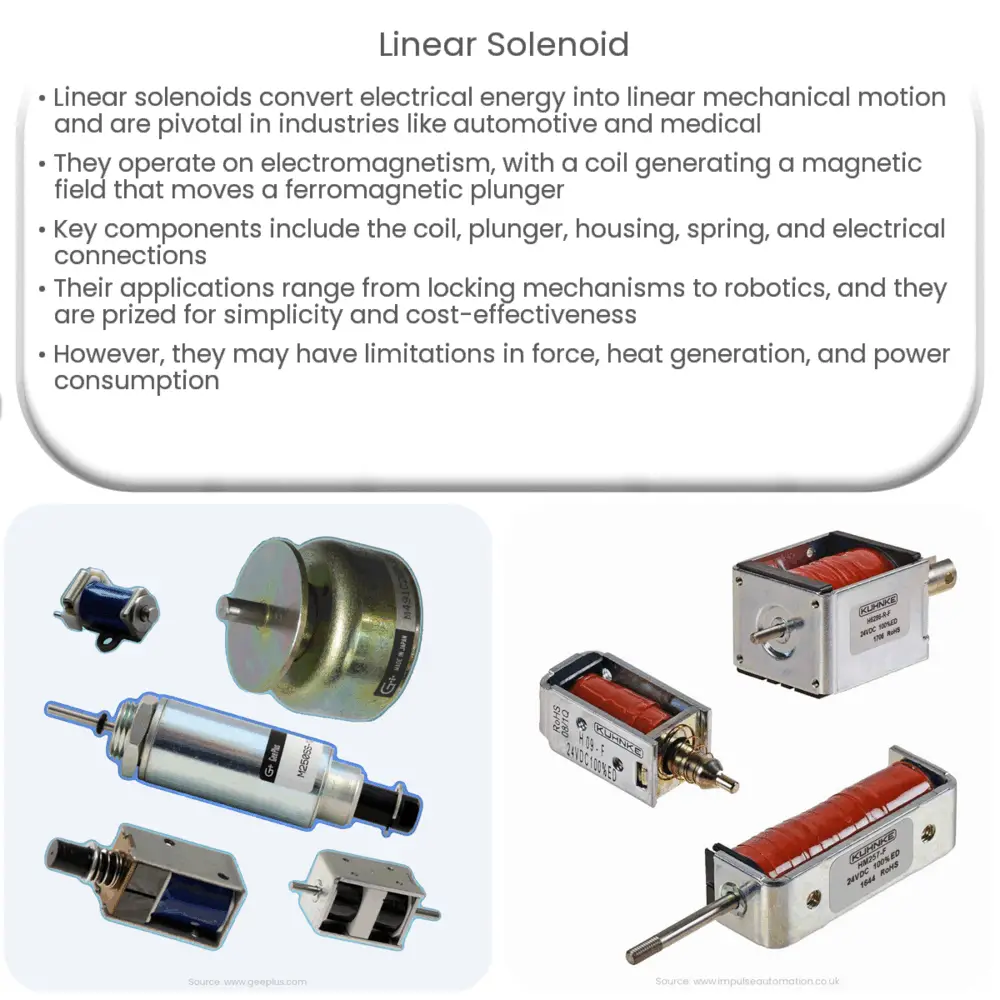A linear solenoid is an electromagnetic device that converts electrical energy into linear motion, commonly used in locking systems, valves, and automation.

Understanding Linear Solenoids: A Comprehensive Guide
Introduction to Linear Solenoids
Linear solenoids are electromagnetic devices that convert electrical energy into linear mechanical motion. They play a crucial role in various applications across industries such as automotive, medical, manufacturing, and aerospace. In this article, we’ll explore the underlying principles of linear solenoids, their components, and common applications.
Operating Principle of Linear Solenoids
A linear solenoid functions based on the principles of electromagnetism. When an electric current flows through a coil of wire, it generates a magnetic field around the coil. The strength of this magnetic field depends on the number of turns in the coil and the amount of current passing through it. Inside the solenoid, there’s a movable plunger made of a ferromagnetic material, which is attracted or repelled by the magnetic field created by the coil.
When the current is applied to the coil, the magnetic field pulls or pushes the plunger, resulting in linear motion. The direction of the motion depends on the orientation of the magnetic field. Once the current is removed, the magnetic field collapses, and the plunger returns to its original position, usually with the assistance of a spring.
Components of a Linear Solenoid
The primary components of a linear solenoid include:
- Coil: The coil is the heart of the solenoid, responsible for generating the magnetic field. It’s typically made from insulated copper wire wound around a cylindrical core, with the number of turns and wire diameter influencing the solenoid’s performance.
- Plunger: The plunger is a movable rod made of ferromagnetic material, such as iron or steel. Its movement within the solenoid produces the linear motion output.
- Housing: The housing encloses the coil and plunger, providing protection and structural support. It can be made from various materials, including metal or plastic, depending on the application requirements.
- Spring: The spring is responsible for returning the plunger to its original position once the current is removed. Springs can vary in stiffness and length, affecting the solenoid’s performance and response time.
- Electrical Connections: Terminals or leads provide a means for electrical connection to the solenoid, allowing current to flow through the coil.
Common Applications of Linear Solenoids
Due to their versatility and simplicity, linear solenoids are used in a wide range of applications, including:
- Locking mechanisms: Door locks, security systems, and safes often rely on solenoids to activate and release locking mechanisms.
- Valve control: Solenoids can regulate the flow of fluids or gases in industrial processes, HVAC systems, and medical equipment.
- Automotive: Linear solenoids can be found in various automotive systems, such as transmission control, fuel injection, and starter motors.
- Robotics and manufacturing: Solenoids are used in robotic arms, conveyors, and other automated systems for precise linear motion control.
Advantages and Disadvantages of Linear Solenoids
Linear solenoids offer several advantages and disadvantages, which should be considered when selecting the right actuator for a specific application:
Advantages
- Simplicity: Linear solenoids have a straightforward design, with few moving parts, making them easy to understand, maintain, and repair.
- Cost-effective: Due to their simple construction, linear solenoids are generally more affordable than other types of actuators, such as pneumatic or hydraulic systems.
- Fast response: Solenoids can achieve high speeds and rapid response times, making them suitable for applications requiring quick and precise motion control.
- Compact size: Linear solenoids are available in various sizes, allowing for easy integration into space-constrained applications.
Disadvantages
- Limited force and stroke length: Linear solenoids typically have a limited force output and stroke length compared to other actuators, which might be insufficient for certain applications.
- Heat generation: Continuous operation of a solenoid can generate significant heat, potentially affecting the performance and lifespan of the device. Adequate cooling or duty cycle management may be necessary in some applications.
- Power consumption: Solenoids require a continuous flow of current to maintain their position, which can result in high power consumption, especially during extended periods of operation.
Selecting the Right Linear Solenoid
When choosing a linear solenoid for a specific application, it’s essential to consider several factors, including:
- Force requirements: Determine the necessary force output based on the application’s load and any additional factors, such as friction or counterforces.
- Stroke length: Ensure the solenoid’s stroke length is sufficient to achieve the desired linear movement.
- Size and mounting constraints: Consider the available space for installation and any mounting requirements.
- Operating environment: Choose a solenoid with suitable materials and protection ratings for the intended operating environment, including temperature, humidity, and exposure to chemicals or contaminants.
- Power consumption and heat dissipation: Evaluate the solenoid’s power requirements and potential heat generation, taking into account any cooling or duty cycle management needs.
- Response time: Ensure the solenoid’s response time meets the application’s speed and precision requirements.
- Cost: Weigh the performance and features of the solenoid against its cost to determine the most suitable option for your budget.
Conclusion
Linear solenoids are versatile and widely used electromechanical devices that convert electrical energy into linear motion. Their simple design, cost-effectiveness, and rapid response make them a popular choice in various applications across industries. Understanding the principles, components, and advantages and disadvantages of linear solenoids, as well as the factors to consider when selecting the right solenoid, can help you make informed decisions for your specific application.

